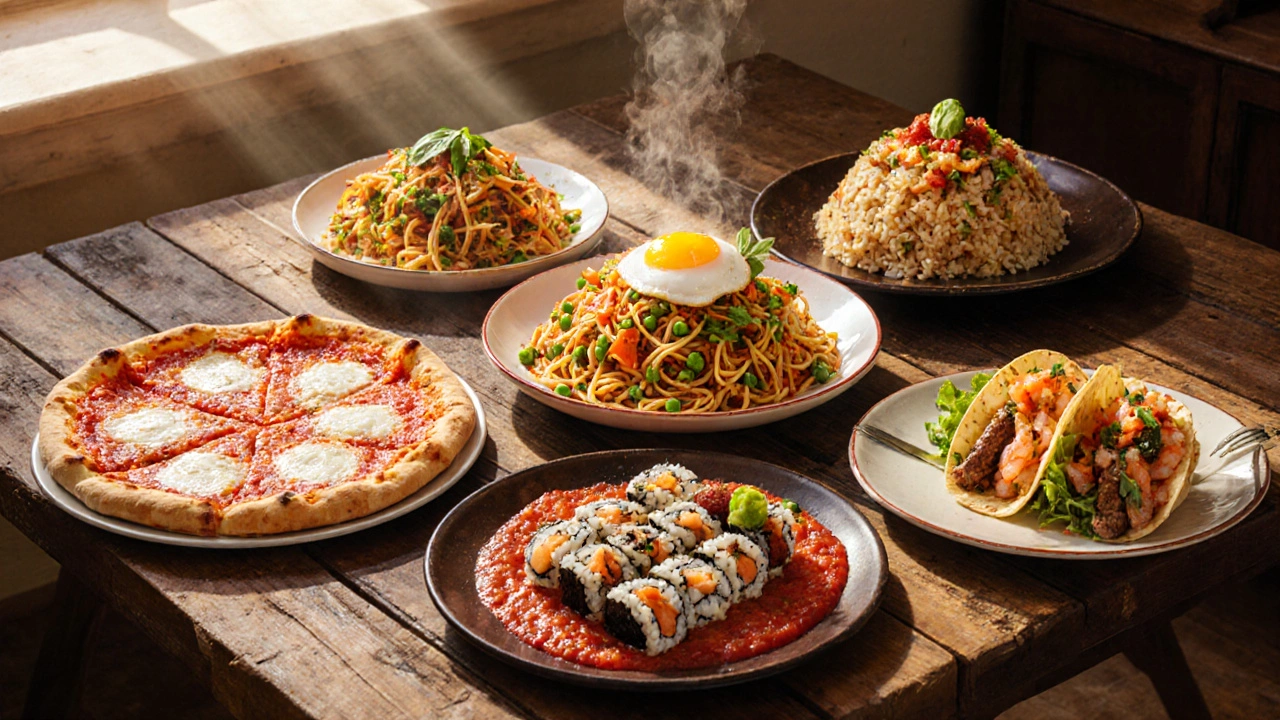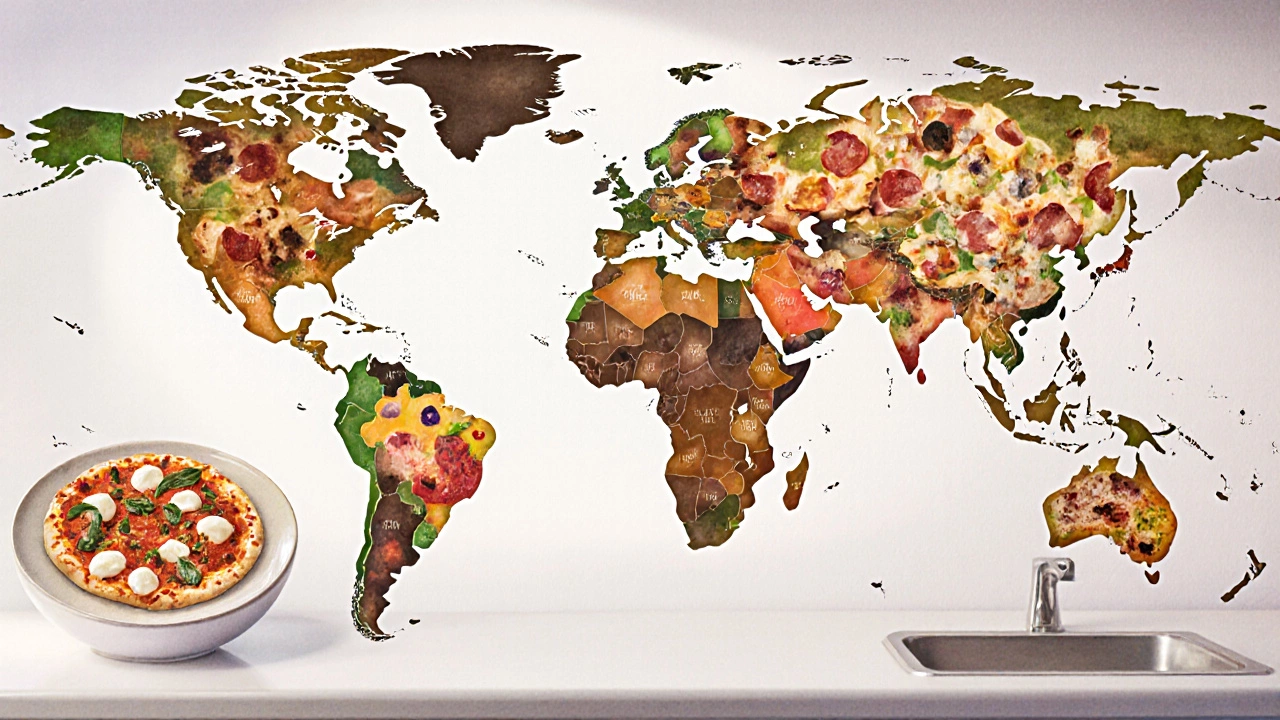Global Dinner Popularity Quiz
Take this quick quiz to test your knowledge about the world's most popular dinner foods. Based on global consumption data, see how well you know the top dishes!
Quiz Results
out of 3 questions answered correctly.
Did You Know?
Pizza's global popularity stems from its convenience, versatility, and strong commercial distribution. It's estimated that pizza generates over $150 billion in annual revenue worldwide!
When you think about dinner around the globe, pizza is widely recognized as the most popular dinner food in the world. That simple slice of dough, sauce and cheese has become a nightly staple for millions, from New York apartments to small towns in Brazil. In this article we’ll explore why pizza tops the list, compare it with other heavyweight contenders, and give you the data you need to understand the global dinner landscape.
Quick Takeaways
- Pizza leads global dinner preference, with roughly 300million weekly servings worldwide.
- Four other dishes - fried rice, pasta, sushi, and tacos - round out the top five.
- Key drivers are convenience, cultural adaptability, and strong commercial distribution.
- Understanding regional twists can help you tailor dinner menus for diverse audiences.
- Revenue from pizza alone surpasses $150billion annually, dwarfing other dinner categories.
How We Ranked Global Dinner Dishes
Our ranking pulls from three main data sources:
- World‑wide restaurant sales reports (e.g., Euromonitor, Statista 2024 data).
- Food‑delivery platform order volumes (Uber Eats, DoorDash, Meituan).
- Household consumption surveys from national statistical agencies.
Each source was normalized to weekly servings permillion people, then weighted 40% sales, 35% delivery orders, and 25% survey data. The resulting index gives a clear picture of what people actually eat for dinner, not just what they say they like.
The Champion: Pizza
Pizza originated in Naples, Italy, in the late 18thcentury. Its core ingredients - wheat‑based dough, tomato sauce, mozzarella cheese - are cheap, shelf‑stable and highly customizable. Today you can find a pizza joint on almost every city block, and the dish has been adapted to local tastes: “Masala pizza” in India, “Tuna mayo pizza” in Japan, and “Halloumi‑and‑mint pizza” in the Middle East.
Key stats that set pizza apart:
- Estimated 300million weekly servings (≈4% of global dinner meals).
- Annual global revenue >$150billion - more than the combined revenue of all fast‑food chains.
- Over 30% of pizza orders are delivered, reflecting its strong presence on delivery apps.
The dish’s success hinges on three factors:
- Convenience: Pre‑made dough and sauce can be stored for weeks, making home preparation fast.
- Versatility: Toppings range from classic pepperoni to vegan cheese, allowing it to fit many dietary preferences.
- Social appeal: Sharing a large pie is a built‑in communal experience, perfect for families and friends.

Close Contenders
While pizza reigns supreme, four other dishes consistently appear near the top of our index.
1. Fried Rice
Fried rice is a staple across East and Southeast Asia, and its simplicity makes it a go‑to dinner worldwide. Typical ingredients are cooked rice, oil, soy sauce, vegetables, and a protein such as egg or shrimp.
- Weekly servings: ~250million.
- Origin: China, with regional variants like Indonesia’s Nasi Goreng and Thailand’s Khao Pad.
- Revenue: ≈$90billion (including restaurant and take‑away sectors).
2. Pasta (Spaghetti)
Spaghetti represents the broader pasta family, which accounts for the second‑largest dinner category in Europe and North America. Classic spaghetti with tomato‑basil sauce is a household staple, while regional twists - such as carbonara, bolognese, or seafood marinara - broaden its appeal.
- Weekly servings: ~210million.
- Origin: Italy, 12thcentury.
- Annual revenue: ≈$110billion.
3. Sushi
Sushi exploded from a Japanese street food to a global gourmet dinner option. Its appeal lies in fresh fish, vinegared rice, and artistic presentation. In the United States alone, sushi restaurant sales topped $13billion in 2023.
- Weekly servings: ~180million.
- Origin: Japan, Edo period.
- Revenue: ≈$70billion worldwide.
4. Tacos
Taco is Mexico’s iconic handheld dinner. The tortilla‑based format accommodates meat, beans, cheese, and fresh salsa, making it adaptable to many taste profiles. Fast‑casual chains have pushed taco consumption beyond Latin America.
- Weekly servings: ~160million.
- Origin: Mexico, pre‑colonial era.
- Revenue: ≈$55billion.
Comparison Table: Top 5 Global Dinner Dishes
| Dish | Origin Country | Main Ingredients | Weekly Servings (million) | Annual Revenue (billion USD) |
|---|---|---|---|---|
| Pizza | Italy | Wheat dough, tomato sauce, cheese | 300 | 150+ |
| Fried Rice | China | Rice, oil, soy sauce, vegetables, protein | 250 | 90 |
| Spaghetti | Italy | Durum wheat pasta, tomato sauce, optional meat | 210 | 110 |
| Sushi | Japan | Vinegared rice, raw fish, seaweed | 180 | 70 |
| Taco | Mexico | Corn tortilla, meat or beans, salsa, cheese | 160 | 55 |
Why Pizza Beats the Rest
Beyond the numbers, there are cultural and logistical reasons that keep pizza ahead.
- Supply chain resilience: Wheat, cheese, and tomato are globally produced, ensuring steady ingredient flow even during crises.
- Franchise model: Chains like Domino’s and PizzaHut have standardized recipes and rapid delivery networks, scaling the dish faster than local eateries.
- Marketing power: Global ad campaigns tie pizza to celebrations - Super Bowl, World Cup, birthday parties - reinforcing its role as a “reward food”.

Regional Flavors: Adapting the Top Dishes
Every continent tweaks the headline dishes to suit local palettes.
| Dish | Region | Local Twist |
|---|---|---|
| Pizza | India | Paneer & green chili topping, naan‑style crust |
| Fried Rice | Indonesia | Nasi Goreng with kecap manis, shrimp paste, and fried egg |
| Spaghetti | United States | Meat‑loaf marinara, extra cheese, garlic bread side |
| Sushi | Brazil | Tempura rolls with tropical fruit fillings |
| Taco | South Korea | Bulgogi tacos with kimchi and gochujang sauce |
These variations show how the core concept can be localized without losing its identity, a key reason for the dishes’ worldwide staying power.
How to Leverage This Insight for Your Dinner Menu
If you run a restaurant, catering service, or even a food‑blog, here are practical steps to capitalize on the global favorites:
- Feature a signature pizza with a local ingredient twist - it’s instantly recognizable and draws crowds.
- Offer a fried‑rice combo that lets diners pick their protein, appealing to both meat‑eaters and vegetarians.
- Include a pasta night with at least two sauce options (tomato‑based and cream‑based) to cover varied preferences.
- Introduce a sushi platter with a mix of traditional and fusion rolls - this adds a premium feel.
- Serve “build‑your‑own” taco stations for a fun, interactive dinner experience.
By aligning menu items with data‑backed favorites, you boost both foot traffic and average ticket size.
Potential Pitfalls & How to Avoid Them
Popularity doesn’t guarantee success. Common mistakes include:
- Over‑standardizing: A pizza that tastes the same everywhere can feel bland. Keep a unique element that reflects your brand.
- Ignoring dietary trends: Gluten‑free, vegan, and low‑carb adaptations are now expected. Offer alternatives for each top dish.
- Neglecting quality sourcing: Cheap ingredients may lower costs short‑term but hurt reputation. Prioritize fresh cheese, quality tomatoes, and authentic rice.
Address these early and you’ll keep the momentum.
Frequently Asked Questions
Which dinner dish is most popular in Europe?
Pizza holds the top spot across most European countries, followed closely by pasta dishes like spaghetti Bolognese. The combination of fast service and local variations keeps pizza ahead.
How reliable are the weekly serving numbers?
The figures blend sales data, delivery app orders, and national consumption surveys, giving a robust cross‑sectional view. While exact counts may shift yearly, the relative ranking remains stable.
Is pizza still the most popular dinner for vegans?
Vegan pizza options have surged, especially in North America and Europe. Although some vegans prefer grain bowls or veggie‑heavy dishes, the convenience and customizability of vegan pizza keep it high on the list.
What factors could dethrone pizza in the future?
A major shift could come from health‑focused meals that dramatically cut carbs or from a new global fast‑food concept that scales faster than pizza chains. Until then, pizza’s entrenched supply chain and cultural cachet make a dethronement unlikely.
How can I make a budget‑friendly pizza at home?
Use store‑bought pizza dough, a simple tomato‑herb sauce, and shredded mozzarella. Top with seasonal veggies or leftover cooked meat. Baking at a high temperature (475°F/245°C) for 10‑12 minutes yields a crisp crust without pricey ingredients.

